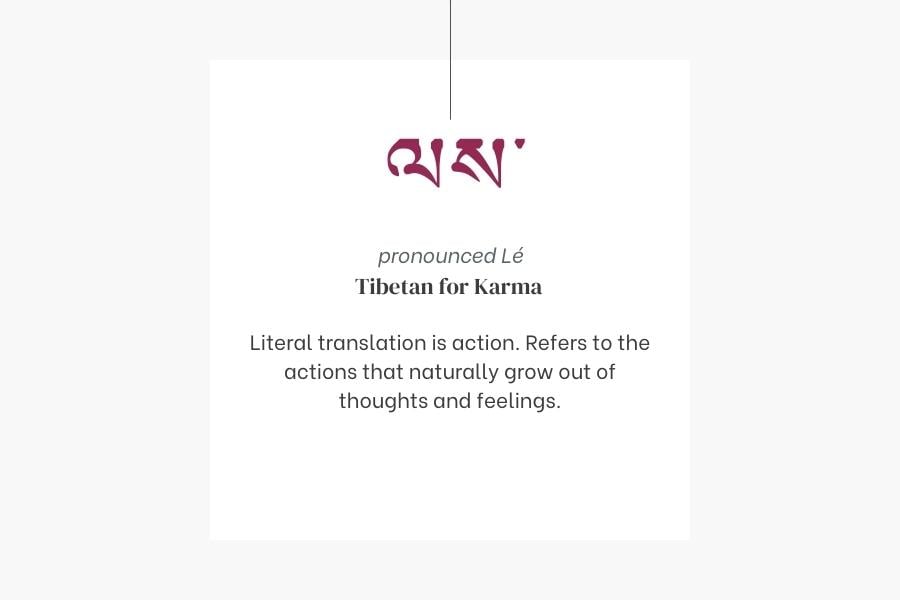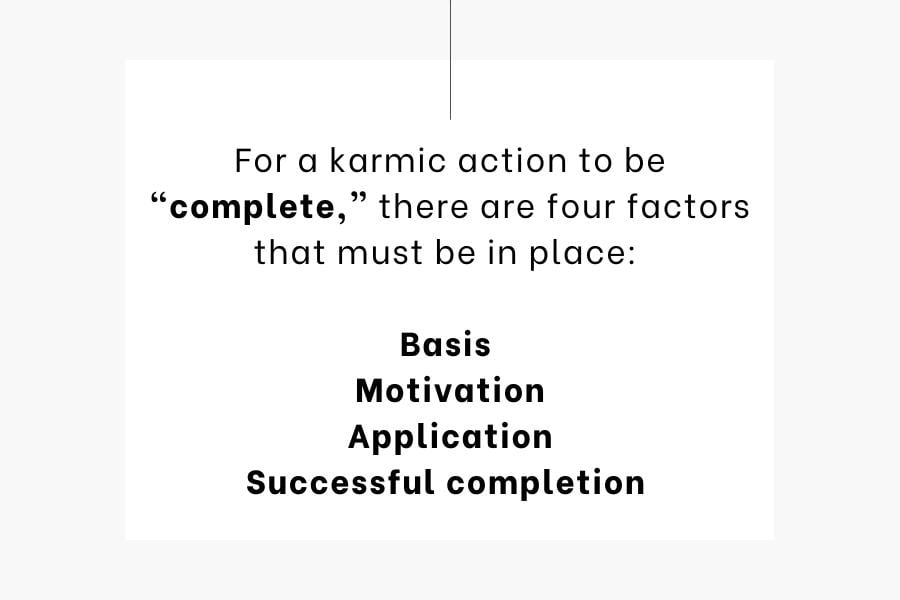Karma: Urges, Actions, and Results Explained
Karma is one of the most complex and misunderstood topics in Buddhism. We’re here to shed a little light on it! Translated from Sanskrit, it means “action.” Generally speaking, karma refers to the actions that naturally grow out of thoughts and feelings.

The thoughts and feelings come from compulsive urges, such as desire and attachment, which lead us to see things, think about them, and act out in certain ways in relation to them. Over time, these actions lead to habits which are either reinforced by continuing to act in those same ways, or diminished by opposing them. In the traditional texts, the presentations of karma primarily focus on four topics: cause and effect, the urge borne of habits of mind (karma itself), actions which are propelled by such an urge, and the effects/results of those actions.
The Law of Cause and Effect in Buddhism
Cause and effect is the basic principle that makes up the foundation of karma. The basic idea is that nothing can come into being without a cause and that certain causes bring about certain effects. For example, a barley seed will only grow barley and not rice or any other plant. In the context of karmic or behavioral cause and effect, virtuous/beneficial actions will bring about results of happiness, and non-virtuous/harmful actions will bring about results of suffering. The traditional texts on karmic cause and effect also give an extensive presentation of the varieties of causes, conditions, and effects that explain the way everything comes into being and is not limited to the context of karma. This topic will be covered later in its own blog, so we’ll just cover a few main points.
First, if all the causes and conditions for something to occur come together and there is nothing opposing its arising, the effect is certain to occur. For example, if a barley seed (the cause) is planted, the conditions of moisture, warmth, sunlight, and nutrients come together, and opposing conditions such as frozen ground, disease, and being trampled by animals, don’t oppose it, a barley plant is certain to grow. Similarly, if you have the karmic seeds of anger and that anger is not opposed by your practice of patience, understanding of emptiness, or a vow or commitment not to get angry, when you meet with someone (the external condition) who says or does something you experience as harmful, your karmic urge will drive you to get angry. You will then think, do, or say something non-virtuous to express that anger. The principle of cause and effect applies to everything in the world. When we say karmic cause and effect or “behavioral” cause and effect, we are discussing how all of these various causes and effects (among which karma is just one) influence everything we think, experience, do, or say.
Buddhism explains that all our experiences and actions are caused by our karmic seeds together with the immediate conditions we meet. So, when our eye consciousness sees someone who we are attracted to (the immediate condition), we have a perception of them being beautiful, a pleasant feeling, and a karmic urge that drives us to think about them or say or do something with them. For now, you can think of this karmic urge as habit or compulsion.
We ordinarily either think, “That person made me mad!”, or “I am in love” or “I got angry,” imagining that there is some independent “I” that is separate from the object of our anger or desire—separate from this whole process. But our sense of self is something that we merely imagine or impute on the basis of various causes and conditions such as our body, feelings, urges, perceptions, and consciousness. Seeing our experience as a process of behavioral causes and effects gives us some freedom from strong self-grasping which itself is the source of our arrogance as well as our self-criticism (another form of self-absorption). This may lead you to think that karma is deterministic and that we have no control over our lives.
Jetsünma Jamyang Palmo gives a good example of this in her talk: “Dependent Origination Versus Hard Determinism.” She says, for example, that if we were to buy a new dress, that purchase would be influenced by internal and external conditions. The internal conditions are our preferences for certain types of dresses, colors, and fits. The external conditions are the latest fashion trends or matching the dress to the season or specific occasion. These external conditions do not arise from our own personal karma, but group karma. Though the latest fashion trends and the seasonal weather are not products of our own personal karma, such external conditions meet with our internal karmic conditions to influence our decisions.
Studying cause and effect in detail leads us to the basic understanding that nothing exists independently without relying upon causes and conditions, a topic which is further clarified in the Mahayana teachings on emptiness.
Karma and Karmic Actions
As we said before, “karma” means action. It is normally discussed in terms of actions and their effects. More specifically, karma is a mental factor defined as an urge that propels one to think, speak, or act. So, karma is an urge, a compulsion that drives us to do things whether we consciously want to do them or not, and not the actions themselves. There are 51 mental factors described in the Buddhist texts, and this urge is one of five that accompanies every consciousness.
What are Karmic Actions?
With every instance of consciousness there is an object to which we have a feeling of some level of happiness, displeasure, or neutrality, an urge to think something or do something in reference to the object, contact with the object, and attentiveness to it. This urge (karma) is the mental factor that, while focused on an object, compels you to think or act in relation to it. Anytime we do something, be it thinking, speaking, or physically acting, there is an urge that leads us to do so. This urge isn’t something conceptual or thought out as would be an intention. For example, we may be sitting on our couch and have the intention to get up and get a glass of water. But we might keep sitting there for another hour until karma propels us to get up and go get it.
So, intentions are more like thoughts whereas karma is a compulsive, habitual urge. These urges can also be at odds with our intentions. For example, we may intend to be patient with a certain person, but the power of our compulsive karmic urges may nonetheless lead us to continue to think of them with anger. This urge toward anger is a “mental karma” because it is an urge that leads to a “mental pathway of karma,” meaning it leads us to a mental action of getting angry. In addition to mental karma, there are physical and verbal karmas that, just like mental karma, are factors which urge one to act physically or verbally. For example, if the karmic urge to anger led you to hit someone, then that would be a physical karma.
How is Karma Created?
For a karmic action to be “complete,” there are four factors that must be in place: a basis, motivation, application, and successful completion of the intended action. We can demonstrate these four in an example of lying to someone. The basis is the person we want to deceive, the motivation is the intention to deceive them together with the desire to deceive them, the application is actually saying the untrue thing, and the act is successfully completed if the person is deceived by our words. There’s a bit to unpack here, so we’ll go through these one by one.

- With the basis, there is the mental factor of recognition or decisiveness, that clearly specifies at what or to whom our thought or action is directed. For example, “I want to eat this and not that.”
- With the motivation, there is an intention to think or do something and an accompanying emotional state that can be virtuous, non-virtuous, or neutral. For example, I could intend to eat something with a neutral emotional state of blind compulsion or out of great desire when I am excited to eat at a new restaurant that I’ve been hearing about. This intention must continue up to the completion of the action or else we may change our minds and not follow through with the intended action. For example, I may intend to lie to my friend about where I am going tonight when, at the last minute, my plans get canceled and I no longer need to lie.
- The application refers to the application of the intention, putting our intention into action. Even the wording helps us to see how important the intention is. If we merely said “the action” it would draw our attention to the action itself, when in Buddhism, the intention is always primary.
- The term “successful completion” is key here. What does it mean for something to be “successfully completed?” It means that if I intended to lie to someone, that they believed my lies. So, what if they didn’t believe me? If they don’t believe me, then I have not deceived them, and therefore my act of lying has become something else, merely an intention to lie. We can see some distinctions in the effects of lying in these two situations. If I successfully deceive someone, it becomes that much easier to keep lying in the future. If I get caught, I am confronted by my deceit, and might feel guilty and reassess my behavior. If nothing else, I may make a negative association with lying because I had to face the consequences of getting caught in a lie and therefore feel less inclined to lie in the future.
Our attitude towards the “successfully completed action” influences the strength of the action to influence our habitual patterns and thereby increase or decrease the likelihood that we will repeat such actions. If we complete the action, but then regret that we did so, this weakens the force of the karmic action to create a habitual urge to repeat the action. Conversely, if we are really happy and proud of what we have done, the force of the habitual urge to repeat such an action is strengthened.
Five Kinds of Karmic Results
- Ripened Result: The ripened result is one that arises later on and not immediately after an action, and primarily refers to the situation of your five aggregates in a future life. This is the basis with which we will live out our lives: our body, feelings, karmic urges, perceptions, and consciousness, all of which are determined by our compulsive (karmic) behavior in previous lives.
- Results that correspond to their causes: These are of two types: results that correspond to their causes in our actions, and results that correspond to their causes in our experience.
- Results that correspond to their causes in our actions are, for example, if we harm others, we will continue to wish to harm them in the future. Understanding this process is important. Karma is the urge that leads us to an intention and an action. By completing the action, we create more karmic urges that keep us in the cycle of compulsive behavior.
- Results that correspond to their causes in our experience are, for example, if I yell at other people, I will experience being yelled at.
The crucial point to understand here is that the result is the experience. My karma is not making the other person yell at me.
For example, if I get hit by a car, it may be my karma that I experience being hit by a car, but my karma did not cause that person to get in their car on that particular day and drive into me. These experiences are experienced with all of our five aggregates: with our bodies, feelings, other mental factors and emotions, perception, and consciousness.
- Dominating Results: This refers to the experience that will dominate our lives in terms of the environment we find ourselves in. For example, if I steal things and use others’ possessions without permission, I will experience poverty and having things taken from me, but also as a dominating result, I will experience being in a society that is poor and unjust. This can be thought of in two ways: one is that others as well experience being in a poor country or society, that it is a collective experience, and another where, no matter what the external situation is, the individual’s experience is dominated by a “poverty mentality.”
- Human-made Results: Oddly, human-made results are not necessarily made by humans! This is just a name that takes humans making things as an example to refer to a particular kind of result. This kind of result is one in which the cause and result are two separate things in the same way that when a human builds a house, the person and the house they build both exist separately and simultaneously.
An opposing example would be our barley seed and the sprout that grows from it. At the time that the sprout is growing, the seed no longer exists separately but has transformed into the resultant sprout. More specifically, this refers to results that come directly after their causes as opposed to those which may ripen later on or even in future lives.
- Results of Separation: Results of separation are not “actual” results in terms of a cause-and-effect relationship. For example, when the wind blows the clouds away and reveals the sun, the sun was not caused by the wind. But as a result of the wind dispersing the clouds, the sun can be seen. This concept applies in the Buddhist path in that when we purify our misdeeds and obscurations by practicing the path, our innate Buddha nature is revealed. Though our Buddha nature is not a result of the path, when it is revealed by purifying our obscurations, we can say that we “attain” Buddhahood even though we did not attain anything new as a direct cause of our actions but merely revealed something which was obscured but always there.
Principles of Karma
- Small actions can bring about great results. Just as a tiny spark can start a great forest fire, we shouldn’t be dismissive of accomplishing small positive thoughts and actions and abandoning negative thoughts and actions, as they can bring about immense helpful or destructive results.
- Karmic results don’t transfer to others like germs! Only we will experience our own karma. This also means that we can’t remove the karma of others and vice versa. The Buddha said that even he cannot simply remove our karma or suffering, and that they can only be overcome through practicing the path. If the Buddha couldn’t do it, it goes without saying that wearing special crystals or having someone play a singing bowl on our chakras isn’t going to do it either.
- We won’t meet with the results of actions we didn’t commit. When you’re experiencing something difficult, you might consider this point. When Tibetans were imprisoned unfairly by the Chinese, they had the view that, in at least one of their countless lives, in their ignorance they must have been imprisoned and harmed others similarly. Now they were burning off that karma, slowly unloading it, while the guards were taking on a karmic load.
- The karmic actions we have committed won’t just go away on their own. We either must experience their results or purify them through specific practices.
Karma, Samsara, and Liberation
Creating positive karma and eliminating negative karma is not the ultimate point of Buddhist practice. Karma, good or bad, together with the afflictive thoughts and emotions are the causes of suffering. Though as beginners on the path, it is important to develop wholesome habits by doing positive things and to reduce and eventually give up our negative habits and actions, ultimately it is like being restrained in gold chains or rusty iron ones. Either way we are still bound to samsara.
Karma is the compulsive urge that keeps us going in the cycle of samsara from lifetime to lifetime, and the only way out is to overcome karma completely. Yes, we must transcend even good karma to attain liberation from samsara! But let’s not get ahead of ourselves. It is always important to be honest and realistic with ourselves in our progress on the path. If we haven’t directly realized the truth of emptiness, we must continue to strive in abandoning negativity and developing wholesome habits and actions. This process will lead us closer to the truth by creating the wholesome conditions that nurture the clarity of our vision of reality.
